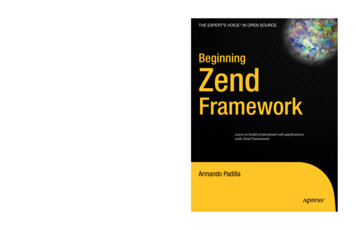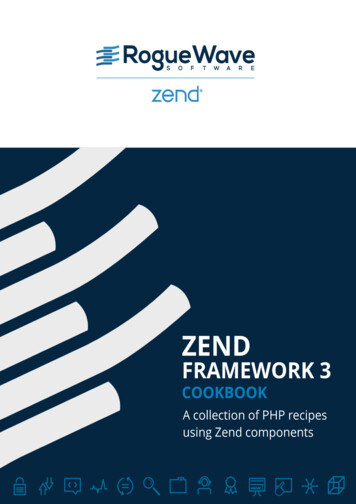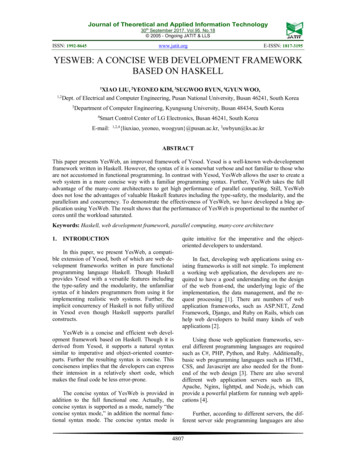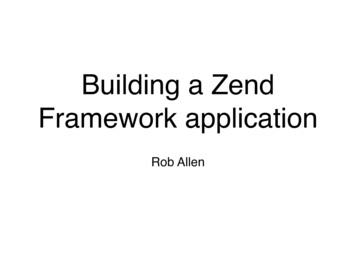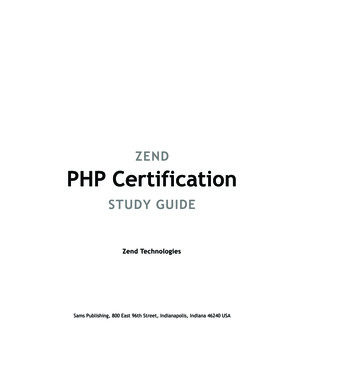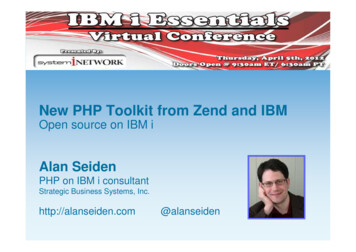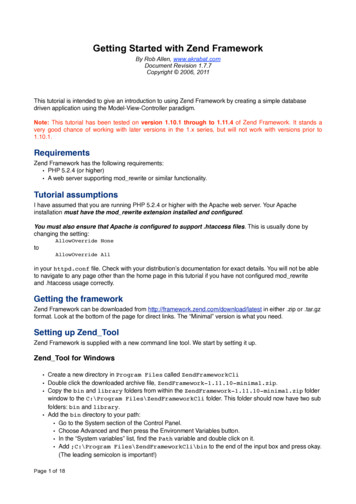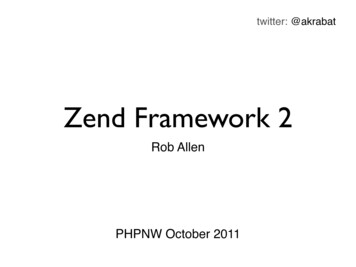
Transcription
twitter: @akrabatZend Framework 2Rob AllenPHPNW October 2011
The experiment
Agenda The state of ZF2ZF2 foundationsA look at a ZF2 MVC application
The state of ZF2
“The primary thrust of ZF 2.0 is to make a moreconsistent, well-documented product, improvingdeveloper productivity and runtime performance.”Matthew Weier O’Phinney
PHP 5.3 & namespacesInterfaces over abstract classesFaster autoloaderConsistent plugin loadingDI & service locatorEvent managerNew MVC system
Pace of development
When?
I still have no idea!
ZF2 foundations
Namespaces
Namespaces are a way ofencapsulating itemsPHP Manual
Namespaces allow us to combine libraries with the same class namesavoid very long class namesorganise our code easily(They also affect functions and constants)
Defining a namespacenamespace My\Db\Statement;class Sqlsrv{}Namespace constant:namespace My\Db\Statement;echo NAMESPACE ;
NamespacesWithin namespace:namespace My\Db\Statement;function testSqlsrv() {! stmt new Sqlsrv ();}Fully qualified: stmt new \My\Db\Statement\Sqlsrv();
ImportSpecific class:use My\Db\Statement\Sqlsrv; stmt new Statement\Sqlsrv();Multiple namespaces:use My\Db\Statement;use My\Db\Adapter; stmt new Statement\Sqlsrv(); adapter new Adapter\Sqlsrv();
ImportYou can’t do this!use Zend\Db\Statement\Sqlsrv;use Zend\Db\Adapter\Sqlsrv; stmt new Sqlsrv (); adapter new Sqlsrv ();
AliasesSolve with aliases:use My\Db\Statement\Sqlsrv as DbStatement;use My\Db\Adapter\Sqlsrv as DbAdapter; stmt new DbStatement (); adapter new DbAdapter();
Namespace resolutionAn unqualified function name is resolved in this order: The current namespace is prepended to the functionname.If the function names doesn't exists in the currentnamespace, then a global function name is used if itexists. date date('Y-m-d');
Namespace resolutionAn unqualified class name is resolved in this order: If there is an import statement that aliases anothername to this class name, then the alias is applied.Otherwise the current namespace is applied. dateTime new \DateTime();
Autoloader
Autoloading allows files to beautomatically included at thelast minute.zendcoding.com
Zend\Loader\Autoloader Class map autoloading, including class mapgeneration PSR-0-compliant per-prefix or namespaceautoloading Fallback PSR-0-compliant include pathautoloading Autoloader factory for loading severalautoloader strategies at once
PSR-0?A standard that describes how to name a class sothat the autoloader can find it.Essentially each namespace maps directly to afolder on disk:i.e.\Zend\Config\Inishould be found in/path/to/Zend/Config/ini.php
StandardAutoloader Inspects classname and finds file on diskLoad via namespace directory pairsLoad via prefix directory pairsFallback search of include path
StandardAutoloaderrequire once ZF2 PATH.'/Loader/StandardAutoloader.php'; loader new Zend\Loader\StandardAutoloader(array('prefixes' array('MyVendor' DIR . '/MyVendor',),'namespaces' array('MyNamespace' DIR . '/MyNamespace',),'fallback autoloader' true,));// register our loader with the SPL autoloader loader- register();
StandardAutoloaderrequire once ZF2 PATH.'/Loader/StandardAutoloader.php'; loader new Zend\Loader\StandardAutoloader(); loader- registerPrefix('MyVendor', DIR .'/MyVendor')- registerNamespace('MyNamespace',DIR .'/MyNamespace')- setFallbackAutoloader(true);// register our loader with the SPL autoloader loader- register();
ClassMapAutoloader Array of class name to file on diskHigh performance!public function autoload( class){if (isset( this- map[ class])) {include this- map[ class];}}
A class mapautoload classmap.php:use My\Db\Statement\Sqlsrv; stmt new Statement\Sqlsrv();Using:require once ZF2 PATH.'/Loader/ClassMapAutoloader.php'; autoLoader new \Zend\Loader\ClassMapAutoloader(array( DIR . '/autoload classmap.php'));// register with the SPL autoloader autoLoader- register();
Multiple class maps loader new \Zend\Loader\ClassMapAutoloader(array(DIR . '/./library/autoload classmap.php',DIR . '/./application/autoload classmap.php',));OR: loader new \Zend\Loader\ClassMapAutoloader(); loader- registerAutoloadMap(array(DIR . '/./library/autoload classmap.php',DIR . '/./application/autoload classmap.php',));
Creating classmapsprompt php path/to/zf2/bin/classmap generator.php -wCreating class file map for library in '/var/www/project/library'.Wrote classmap file to '/var/www/project/library/autoload classmap.php'
Combining autoloaders Use class maps and the prefixes!Very useful in developmentUse ZF2’s AutoloaderFactory class
require once ZF2 PATH . toloader' array(DIR . '/./library/Zend/autoload classmap.php',),'Zend\Loader\StandardAutoloader' array('prefixes' array('MyVendor' DIR . '/MyVendor',),'namespaces' array('MyNamespace' DIR . '/MyNamespace',),'fallback autoloader' true,),));
Autoloader summary Use the class map one in preference as it’sreally really fast! Prefix directory pairs is surprisingly fastthough compared to ZF1
ExerciseUpdate the ZF1 Tutorial to use the Autoloader fromZF2:1. Using StandardAutoloader2. Using a classmap for library code and aStandardAutoloader for the application code.
Dependency Injection
Dependency injection meansgiving an object its instancevariables. Really. That's it.James Shore
Contrived exampleclass Album{protected artist;public function getArtistName(){return artist- getName();}}
How do we set the artistmember variable?
Direct instantiationclass Album{protected artist;public function construct(){ this- artist new Artist();}// etc}
Constructor injectionclass Album{protected artist;public function construct(Artist artist){ this- artist artist;}// etc}Calling code: album new Album( artist);
Constructor injectionclass Album{protected artist;public function construct(Artist artist){ this- artist artist;}// etc}Calling code: album new Album( artist);
Setter injectionclass Album{protected artist;public function setArtist(Artist artist){ this- artist artist;}// etc}Calling code: album new Album(); album- setArtist( artist);
Advantages Can use different objects (e.g. SoloArtist)Configuration is naturalTesting is simplifiedDo not need to change the Album classDisadvantagesInstantiation and configuration of a class’dependencies are the responsibility of the callingcode.
Dependency Injection Containerclass AlbumContainer{public static artist;public static function createAlbum(){ album new Album(); album- setArtist(self:: artist);// more setXxx() calls here as requiredreturn album;}}Calling code: album AlbumContainer::createAlbum();
A dependency injectioncontainer is a component thatholds dependency definitionsand instantiates them for you.
Zend\Di Supports constructor and setter injectionConfigured in code or via config fileType hinting makes life easier
Constructor injectionnamespace My;class Artist{}class Album{protected artist null;public function construct (Artist artist){ this- artist artist;}}
To use an album: di new Zend\Di\DependencyInjector(); album di- get('My\Album');Also: album2 di- newInstance('My\Album');
Parameters in dependenciesclass Artist{protected name;public function construct( name){ this- name name;}}Use setParameters: di new Zend\Di\DependencyInjector(); di- getInstanceManager()! - setParameters('Artist', array('name' 'Queen'));
Parameters in dependenciesUsage: album di- get('My\Album');Set at call time: album di- get('My\Album',array('name' 'Jonathan Coulton'));
Setter injectionnamespace My;class Artist{protected name;public function construct( name){ this- name name;}}class Album{protected artist null;public function setArtist(Artist artist){ this- artist artist;}}
To use an album:Enable: di- getDefinition()- getIntrospectionRuleset()- addSetterRule('paramCanBeOptional', false);Use: album di- get('My\Album', array('name' 'Train'));
Definitions RuntimeDefinition BuilderDefinition Programmatic creation via Builder\PhpClassArrayDefinition Resolves at runtime (reflection-based)Dependencies defined in an arrayAggregateDefinition Combine different definitions
BuilderDefinitionuse Zend\Di\DependencyInjector, Zend\Di\Definition,Zend\Di\Definition\Builder;// Builder definition for My\Album method new Builder\InjectionMethod(); method- setName('setArtist'); method- addParameter('artist', 'My\Artist'); class new Builder\PhpClass(); class- setName('My\Album'); class- addInjectionMethod( method); builderDef new Definition\BuilderDefinition(); builderDef- addClass( class); di new DependencyInjector(); di- setDefinition( builderDef);
Compilation to ArrayDefinitionuse Zend\Di,! Zend\Code\Scanner\ScannerDirectory; compiler new Di\Definition\Compiler(); compiler- addCodeScannerDirectory(new ScannerDirectory('path/to/library/My/')); definition compiler- compile(); di new Di\DependencyInjector(); di- setDefinition( definition); album di- get('My\Album', array('Oasis'));
Persistancefile put contents(DIR . '/di-definition.php',' ?php return ' .var export( definition- toArray(), true) . ';');Load: definition new Zend\Di\Definition\ArrayDefinition(include DIR . '/di-definition.php');
Aliases Makes it easier to specify dependenciesCan retrieve from the injector by alias too. di new Zend\Di\DependencyInjector(); im di- getInstanceManager(); im- addAlias('artist', 'My\Artist'); im- addAlias('album', 'My\Album'); im- setParameters('artist', array('name' 'Blur')); artist di- get("artist"); album di- get("album", array("name" "Queen"));
ConfigurationConfig file:[production]di.instance.alias.album 'My\Album'di.instance.alias.artist 'My\Artist'di.instance.artist.parameters.name 'Marillion'PHP file:use Zend\Config, Zend\Di; config new Config\Ini('application.ini', 'dev'); diConfig new Di\Configuration( config- di); di new Di\DependencyInjector( diConfig); artist di- get("artist"); album di- get("album", array("name" "Queen"));
Aggregationuse Zend\Di\Definition; arrayDef new Definition\ArrayDefinition(include DIR . '/di-definition.php'); runtimeDef new Definition\RuntimeDefinition();// Aggregate the two definitions aggregateDef new Definition\AggregateDefinition(); aggregateDef- addDefinition( arrayDef); aggregateDef- addDefinition( runtimeDef); di new \Zend\Di\DependencyInjector(); di- setDefinition( aggregateDef);
DI summary DI allows defining dependencies independentof the calling code You still need to wire things up - it’s just all inone place with DIC. This is used extensively in the MVC system
Event Manager
Event Manager allows a class topublish events which othercomponents can listen for andact when that event occurs.Me!
Terminology An Event Manager is an object thataggregates listeners for one or more namedevents, and which triggers events. A Listener is a callback that can react to anevent. An Event is an action.A Target is an object that creates events(Shameless stolen from Matthew Weier O’Phinney!)
Simple exampleuse vent; callback function( event) {echo "An event has happened!\n";var dump( event- getName());var dump( event- getParams());}; eventManager new EventManager(); eventManager- attach('eventName', callback);echo "\nRaise an event\n"; eventManager- trigger('eventName', null,array('one' 1, 'two' 2));
Targetuse vent;class MyTarget{public eventManager;public function construct(){ this- eventManager new EventManager();}public function doIt(){ event new Event(); event- setTarget( this); event- setParam('one', 1); event- setParam('two', 2); this- eventManager- trigger('doIt.pre', event);}}
Target callback function ( event) {echo "Responding to doIt.pre!\n";var dump(get class( event- getTarget()));var dump( event- getName());var dump( event- getParams());}; target new MyTarget(); target- eventManager- attach('doIt.pre', callback); target- doIt();
StaticEventManagerclass MyTarget{public eventManager;public function construct(){ this- eventManager new EventManager( CLASS );}// etc}// attach a listeneruse Zend\EventManager\StaticEventManager; events StaticEventManager::getInstance(); events- attach('MyTarget', 'doIt.pre', callback);// cause event to trigger target- doIt();
StaticEventManager Statically attached listeners are called after thedirectly attached ones. The identifier can be an array: this- eventManager new EventManager(array( CLASS , get called class()));Allows for attaching to generic parent class orspecific child Disable statically attached listeners: Re-enable: this- eventManager- setStaticConnections(null); this- eventManager- ce());
Listener aggregates HandlerAggregate interface provides forattaching and detaching event listeners Two methods: attach(EventCollection events) detach(EventCollection events) (EventCollection is the interface thatEventManager implements)
Using HandlerAggregateclass MyListener implements HandlerAggregate{protected eventHandlers array();public function attach(EventCollection events){ this- handlers[] events- attach('event1',array( this, 'doSomething')); this- handlers[] events- attach('event2',array( this, 'doSomethingElse'));}public function detach(EventCollection events){foreach ( this- handlers as key handler) { events- detach( handler);unset( this- handlers[ key]);} this- handlers array();}
Using HandlerAggregate target new MyTarget();// Attach the target's event manager to the listener listener new MyListener(); listener- attach( target- getEventManager());// Now we can trigger some events target- doSomething(); target- doSomethingElse();// Detach listener- detach( target- getEventManager());// this trigger will not fire the listener’s target- doSomething();
Returned values from listenerspublic function triggerEvent1(){ results this- eventManager- trigger('event1', this);foreach ( results as result) {var dump( result);}} results is a ResponseCollection results are in reverse order (latest triggeredevent is first)
Short-circuitingpublic function triggerEvent1(){ results this- eventManager- trigger('event1', this);foreach ( results as result) {var dump( result);}} results is a ResponseCollection results are in reverse order (latest triggeredevent is first)
Short-circuitingpublic function doIt(){ params array('id' 1); results this- eventManager- trigger('doIt.pre', this, params,function ( result) {if( result 'done') {return true;}return false;});if ( results- stopped()) {// We ended early}}
Priority Control the order of execution of listeners priority is last parameter to attach() eventManager- attach('doIt.pre', callback, priority); Default is 1 Larger increases prioritySmaller decreases priority
EventManager summary Decouples objects from one anotherIncreases flexibilityExpect to use in MVC system
ExerciseUsing the ZF2 EventManager, add logging toApplication Models DbTable Albums(I have created Application Model Loggeras a starting point for you.)
A ZF2 Application
This is very muchPROTOTYPE code
ExerciseUse the ZF2 Skeleton Application and SkeletonModule to create a website that displays a randomquote on the home page.
Resources http://framework.zend.com/zf2 e dSkeletonApplication
Thank youfeedback: http://joind.in/3459email: rob@akrabat.comtwitter: @akrabat
Zend Framework 2 Rob Allen PHPNW October 2011 twitter: @akrabat. The experiment. Agenda . developer productivity and runtime performance." Matthew Weier O'Phinney PHP 5.3 & namespaces

